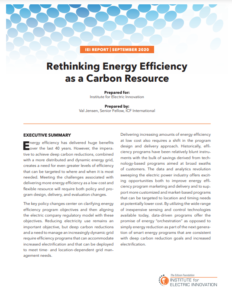Full Title: Rethinking Energy Efficiency as a Carbon Resource
Author(s): Val Jensen
Publisher(s): The Edison Foundation Institute for Electric Innovation, ICF International
Publication Date: September 15, 2020
Full Text: Download Resource
Description (excerpt):
Electric company-administered energy efficiency programs have been offered for 40 years. Since the early 1990s, investment in customer-funded electricity efficiency has climbed from $1.8 billion (spent mostly in California, the Northeast, and the Northwest) to more than $7.23 billion in 2018 with investment occurring across the country. This investment drove substantial impact; over that same period, total annual energy savings grew from just less than 50 billion kilowatt-hours (kWh) to 211 billion kWh. Absent this investment, 2018 electricity use would have been almost 7 percent higher. Roughly 20 percent of the carbon dioxide (CO2 ) reductions coming from the electric power sector since 2005 have been the result of reduced energy use. In 2018, the magnitude of energy efficiency savings (211 billion kWh) was more than double the output of solar generation (96 billion kWh).
Despite this success or perhaps because of it, there is a growing sense across the industry that “what got us here won’t get us there,” where “there” is a largely clean energy economy underpinned by a very different electric power industry. Successfully achieving deep carbon reductions will require both further reductions in energy use at least as great as those already achieved and the replacement of significant existing fossil generation with zero-carbon technologies. Most industry experts expect these zero-carbon technologies to be largely wind and solar; and variable and, in some cases, distributed technologies that require reengineering the grid, particularly at the distribution level to accommodate variable and two-way power flows. Today, nuclear energy generates the majority of zero-carbon electricity in the United States (52 percent), followed by wind energy (19 percent), hydropower (18 percent), and solar energy (7 percent). Energy efficiency typically is not considered in the zero-carbon resource mix.
